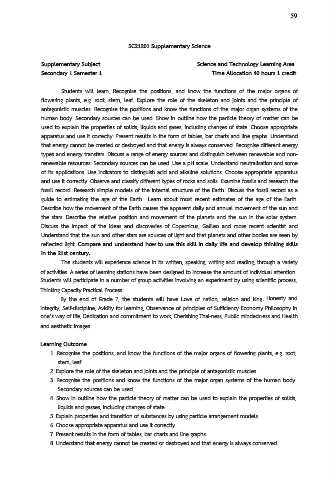Page 61 - เล่ม 65 ม.ต้น หลักสูตรสถานศึกษาโรงเรียนมงฟอร์ต
P. 61
59
SC21201 Supplementary Science
Supplementary Subject Science and Technology Learning Area
Secondary 1 Semester 1 Time Allocation 40 hours 1 credit
Students will learn, Recognise the positions, and know the functions of the major organs of
flowering plants, e.g. root, stem, leaf. Explore the role of the skeleton and joints and the principle of
antagonistic muscles. Recognise the positions and know the functions of the major organ systems of the
human body. Secondary sources can be used. Show in outline how the particle theory of matter can be
used to explain the properties of solids, liquids and gases, including changes of state. Choose appropriate
apparatus and use it correctly. Present results in the form of tables, bar charts and line graphs. Understand
that energy cannot be created or destroyed and that energy is always conserved. Recognise different energy
types and energy transfers. Discuss a range of energy sources and distinguish between renewable and non-
renewable resources. Secondary sources can be used. Use a pH scale. Understand neutralisation and some
of its applications. Use indicators to distinguish acid and alkaline solutions. Choose appropriate apparatus
and use it correctly. Observe and classify different types of rocks and soils. Examine fossils and research the
fossil record. Research simple models of the internal structure of the Earth. Discuss the fossil record as a
guide to estimating the age of the Earth. Learn about most recent estimates of the age of the Earth.
Describe how the movement of the Earth causes the apparent daily and annual movement of the sun and
the stars. Describe the relative position and movement of the planets and the sun in the solar system.
Discuss the impact of the ideas and discoveries of Copernicus, Galileo and more recent scientist and
Understand that the sun and other stars are sources of light and that planets and other bodies are seen by
reflected light. Compare and understand how to use this skill in daily life and develop thinking skills
in the 21st century.
The students will experience science in its written, speaking, writing and reading, through a variety
of activities .A series of learning stations have been designed to increase the amount of individual attention.
Students will participate in a number of group activities involving an experiment by using scientific process,
Thinking Capacity Practical Process
By the end of Grade 7, the students will have Love of nation, religion and king, Honesty and
integrity, Self-discipline, Avidity for learning, Observance of principles of Sufficiency Economy Philosophy in
one’s way of life, Dedication and commitment to work, Cherishing Thai-ness, Public mindedness and Health
and aesthetic images.
Learning Outcome
1. Recognise the positions, and know the functions of the major organs of flowering plants, e.g. root,
stem, leaf.
2. Explore the role of the skeleton and joints and the principle of antagonistic muscles.
3. Recognise the positions and know the functions of the major organ systems of the human body.
Secondary sources can be used.
4. Show in outline how the particle theory of matter can be used to explain the properties of solids,
liquids and gasses, including changes of state.
5. Explain properties and transition of substances by using particle arrangement models.
6. Choose appropriate apparatus and use it correctly.
7. Present results in the form of tables, bar charts and line graphs.
8. Understand that energy cannot be created or destroyed and that energy is always conserved.

